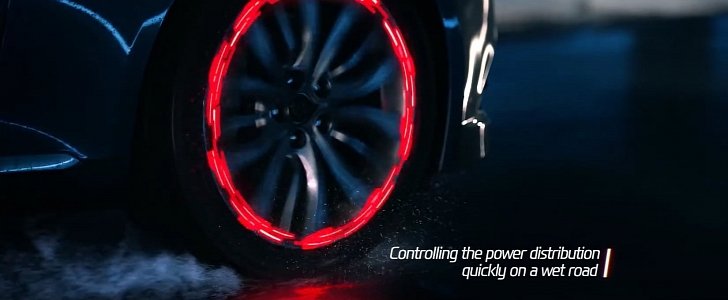Hyundai may be late to the AWD premium sedan party, but the new Genesis makes its arrival with a chassis that's been honed at the Nurburgring. What's more, you can now have it with all-wheel-drive. But why do you even need that on something other than an SUV?
To answer that question, engineers organized a little light show. They installed several strips of LEDs on all four wheels, a bit like what people do to their bicycles. This helps us better visualize how each corner of the Genesis behaves.
They then put the car to the test on a skid track. When the vehicle senses one axle loses traction, power is sent to the other one. Of course, most AWD systems behave that way, but the Genesis still manages to impress us.
So should we take the Genesis seriously? It doesn't matter. Hyundai has already built a loyal fan base, with 100,000 units being delivered in the initial 18 months after its launch.
The car company says the new Genesis is especially popular in America, where it's the number three best-selling model in the midsize luxury segment. Prices start at $38,000 for a rear-drive model with the 3.8-liter V6 GDi and jump to $51,500 for the Tau 5-liter V8. The company has set a US sales target of 25,000 for 2015 and 30k for the next year. However, South Korea remains the biggest market.
The HTRAC all-wheel drive system was developed as a multi-mode system, providing an electronic, variable-torque-split clutch with active torque control between the front and rear axles. Under regular conditions, you either use the Normal or the Eco mode. However, there's also a Sport setting that gives a more tail-happy feel by sending more of the available torque to the rear wheels.
Furthermore, the system can direct more of the available torque to the rear wheels during steady highway cruising for reduced powertrain losses and NVH levels. Hyundai says HTRAC has been tuned to variable conditions such as straight-line acceleration, medium- and high-speed cornering.
They then put the car to the test on a skid track. When the vehicle senses one axle loses traction, power is sent to the other one. Of course, most AWD systems behave that way, but the Genesis still manages to impress us.
So should we take the Genesis seriously? It doesn't matter. Hyundai has already built a loyal fan base, with 100,000 units being delivered in the initial 18 months after its launch.
The car company says the new Genesis is especially popular in America, where it's the number three best-selling model in the midsize luxury segment. Prices start at $38,000 for a rear-drive model with the 3.8-liter V6 GDi and jump to $51,500 for the Tau 5-liter V8. The company has set a US sales target of 25,000 for 2015 and 30k for the next year. However, South Korea remains the biggest market.
The HTRAC all-wheel drive system was developed as a multi-mode system, providing an electronic, variable-torque-split clutch with active torque control between the front and rear axles. Under regular conditions, you either use the Normal or the Eco mode. However, there's also a Sport setting that gives a more tail-happy feel by sending more of the available torque to the rear wheels.
Furthermore, the system can direct more of the available torque to the rear wheels during steady highway cruising for reduced powertrain losses and NVH levels. Hyundai says HTRAC has been tuned to variable conditions such as straight-line acceleration, medium- and high-speed cornering.


